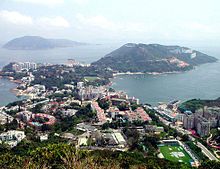

This article needs additional citations for verification. Please help improve this articlebyadding citations to reliable sources. Unsourced material may be challenged and removed.
Find sources: "Po Toi Islands" – news · newspapers · books · scholar · JSTOR (May 2011) (Learn how and when to remove this message) |
蒲台羣島
| |
|---|---|

Aerial view of Waglan Island (foreground), Po Toi (left), Lo Chau and Sung Kong from the east
| |

Location of Po Toi Islands within Hong Kong.
| |
| Geography | |
| Location | South-east of Hong Kong Island |
| Coordinates | 22°10′27″N 114°16′14″E / 22.1742°N 114.2705°E / 22.1742; 114.2705 |
| Major islands | Po Toi Island |
| Administration | |
| District | Islands District |
| Demographics | |
| Population | 200 |
| Po Toi Islands | |||||||||||||
|---|---|---|---|---|---|---|---|---|---|---|---|---|---|
| Traditional Chinese | 蒲台羣島/ 蒲苔羣島 | ||||||||||||
| Simplified Chinese | 蒲台群岛/ 蒲苔群岛 | ||||||||||||
| |||||||||||||
The Po Toi Islands are a small group of islands with a population of around 200, south-east of Hong Kong Island, off Stanley, in Hong Kong. The main island of the group is Po Toi Island. Administratively, they are part of Islands District.[1]
The islands are notable for interesting rock formations and open-air seafood restaurants. Po Toi Island has a "haunted house", and some rock carvings supposed to be the epitaph of an emperor who died on or near Po Toi.[citation needed] Waglan Island has one of the five surviving pre-war lighthouses in Hong Kong.[2]




Po Toi Islands include:

For the origin of the name, see Po Toi.
The islands are accessible by private ferry (kai-to) or water taxi. Scheduled ferries connect Po Toi island with Aberdeen and Stanley.[3]
|
| |||||||||
|---|---|---|---|---|---|---|---|---|---|
| Areas |
| ||||||||
| Landmarks |
| ||||||||
| Transport |
| ||||||||
| Islands |
| ||||||||
| Culture |
| ||||||||
| Education |
| ||||||||
This list is incomplete. | |||||||||
This New Territories location article is a stub. You can help Wikipedia by expanding it. |